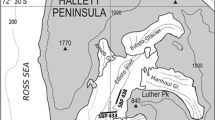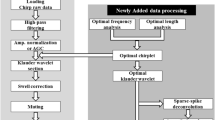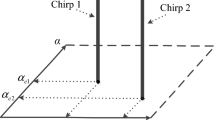Abstract
Chirp frequency-modulated (FM) systems offer deterministic, repeatable source-signatures for high-resolution, normal incidence marine seismic reflection data acquisition. An optimal processing sequence for uncorrelated Chirp data is presented to demonstrate the applicability of some conventional seismic reflection algorithms to high-resolution data sets, and to emphasise the importance of a known source-signature. An improvement of greater than 60dB in the signal- to-noise ratio is realised from correlating the FM reflection data with the transmitted pulse. Interpretability of ringy deconvolved data is enhanced by the calculation of instantaneous amplitudes. The signal-to-noise ratio and lateral reflector continuity are both improved by the application of predictive filters whose effectiveness are aided by the repeatability of the Chirp source.
Similar content being viewed by others
References
Advance Geophysical Corporation, 1995, ProMAXT M 6.0 User Manual.
Bull, J. M., Quinn, R., and Dix, J. K., 1998, Reflection coefficient calculation from marine high-resolution seismic reflection (Chirp) data and application to an archaeological case study: Marine Geophysical Researches 20, 1–11.
Canales, 1984, Random noise reduction. Paper presented at the Society of Exploration Geophysicists 54th Annual Conference, Atlanta, GA.
Gulunay, N., 1986, FX-deconvolution and the complex Wiener prediction filter for random noise reduction. Paper presented at the Society of Exploration Geophysicists 56th Annual Conference, Houston, TX.
LeBlanc, L. R., Panda, S., and Schock, S. G., 1992a, Sonar attenuation modeling for classification of marine sediments, J. Acoust. Soc. Am. 91, 116–126.
LeBlanc, L. R., Mayer, L., Rufino, M., Schock, S. G. and King, J., 1992b, Marine sediment classification using the chirp sonar: J. Acoust. Soc. Am. 91, 107–115.
Panda, S., LeBlanc, L. R., and Schock, S. G., 1994, Sediment classification based on impedance and attenuation estimation, J. Acoust. Soc. Am. 95, 3022–3055.
Schock, S. G., LeBlanc, L. R. and Mayer, L. A., 1989, Chirp subbottom profiler for quantitative sediment analysis, Geophysics 54, 445–450.
West, I. M. (1980) Geology of the Solent Estuarine System, In: The Solent Estuarine System: An assessment of present knowledge, NERC Pub. Series C 22, 6–17.
Yilmaz, O., 1987, Seismic Data Processing. Society of Exploration Geophysicists, Tulsa, OK.
Author information
Authors and Affiliations
Rights and permissions
About this article
Cite this article
Quinn, R., Bull, J. & Dix, J. Optimal Processing of Marine High-Resolution Seismic Reflection (Chirp) Data. Marine Geophysical Researches 20, 13–20 (1998). https://doi.org/10.1023/A:1004349805280
Issue Date:
DOI: https://doi.org/10.1023/A:1004349805280




